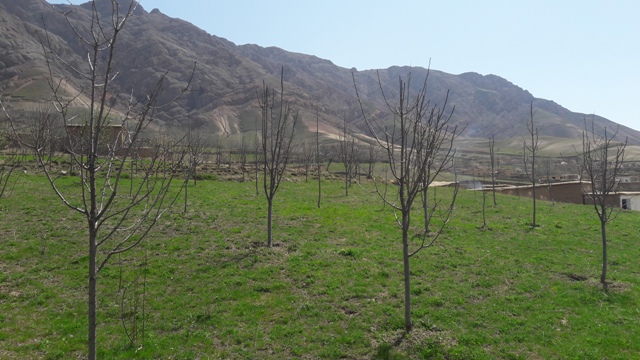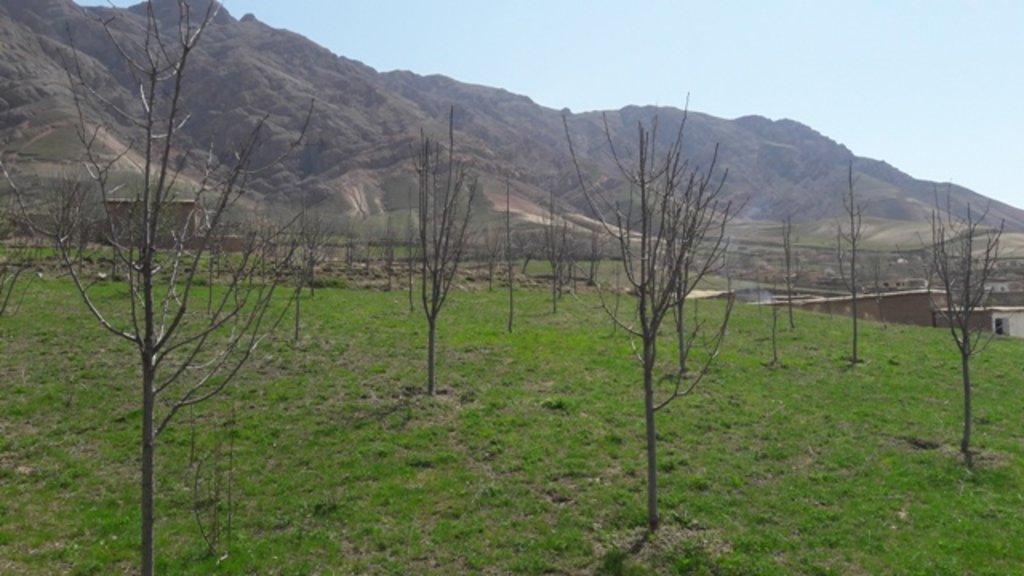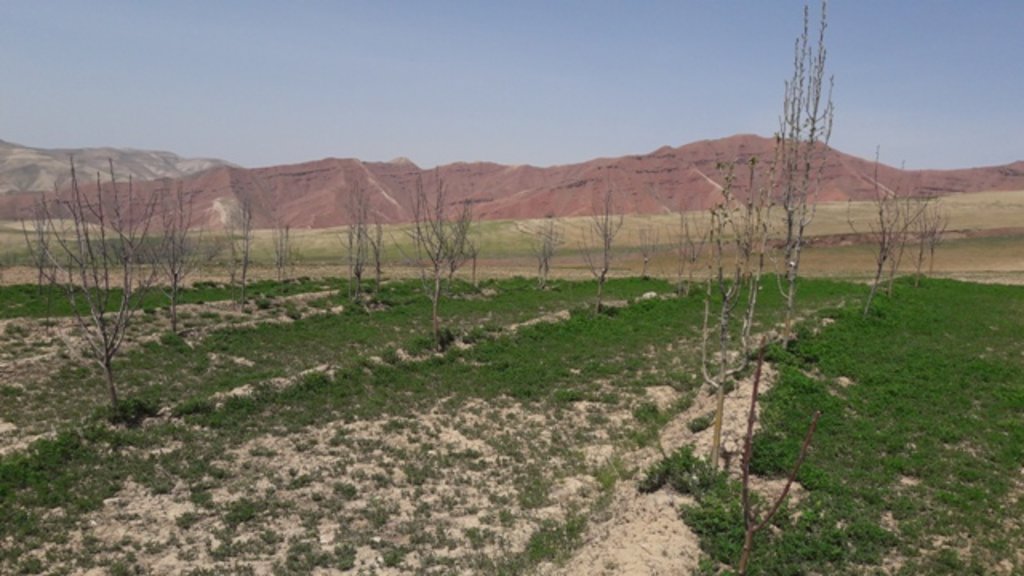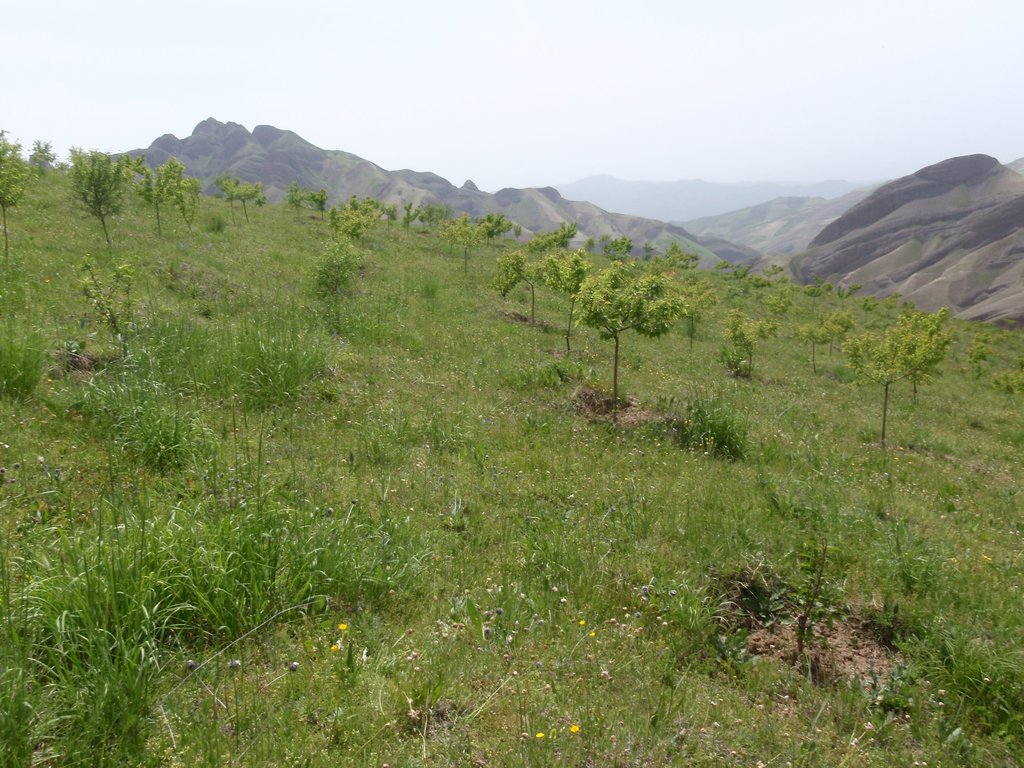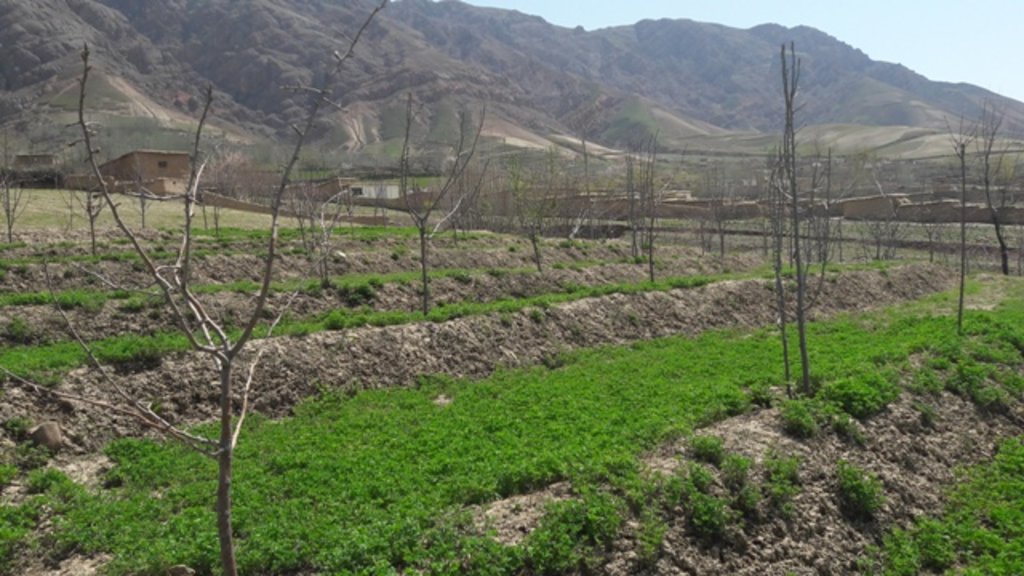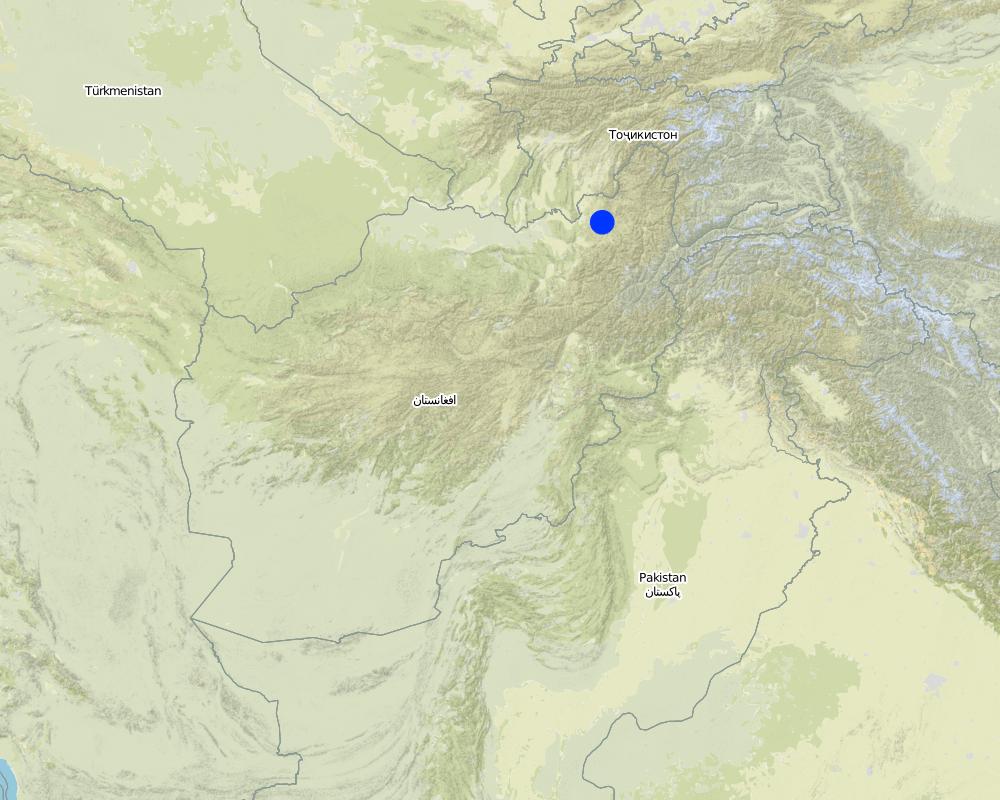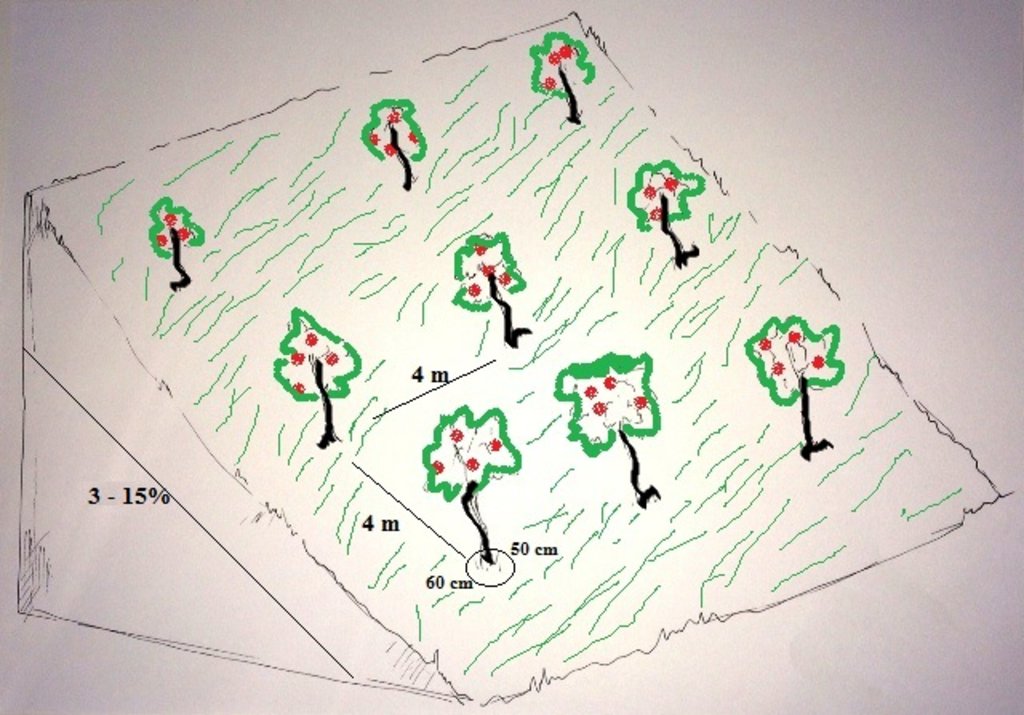Establishment of improved orchards and vineyards [Afeganistão]
- Criação:
- Atualização:
- Compilador/a: Bettina Wolfgramm
- Editor: Roziya Kirgizbekova
- Revisor: Rima Mekdaschi Studer
Bunyodi boghi va boghi anguri behbudyofta
technologies_669 - Afeganistão
Veja as seções
Expandir tudo Recolher tudo1. Informação geral
1.2 Detalhes do contato das pessoas capacitadas e instituições envolvidas na avaliação e documentação da tecnologia
Pessoa(s) capacitada(s)
usuário de terra:
Mirza Bay Gholam Sakhi
Natural Resources Management Comittee (NRMC)
Sari Joy Village, Rustaq District
Afeganistão
Especialista em GST:
Especialista em GST:
Researcher:
Nome do projeto que facilitou a documentação/avaliação da Tecnologia (se relevante)
Livelihood Improvement Project Takhar, Afghanistan (LIPT)Nome do projeto que facilitou a documentação/avaliação da Tecnologia (se relevante)
Potential and limitations for improved natural resource management (NRM) in mountain communities in the Rustaq district, Afghanistan (Rustaq NRM Study)Nome da(s) instituição(ões) que facilitou(ram) a documentação/ avaliação da Tecnologia (se relevante)
Terre des Hommes (Terre des Hommes) - SuíçaNome da(s) instituição(ões) que facilitou(ram) a documentação/ avaliação da Tecnologia (se relevante)
Swiss Agency for Development and Cooperation (DEZA / COSUDE / DDC / SDC) - SuíçaNome da(s) instituição(ões) que facilitou(ram) a documentação/ avaliação da Tecnologia (se relevante)
Bern University of Applied Sciences, School of Agricultural, Forest and Food Sciences (HAFL) - SuíçaNome da(s) instituição(ões) que facilitou(ram) a documentação/ avaliação da Tecnologia (se relevante)
CDE Centre for Development and Environment (CDE Centre for Development and Environment) - Suíça1.3 Condições em relação ao uso da informação documentada através de WOCAT
Quando os dados foram compilados (no campo)?
27/10/2016
O/a compilador/a e a(s) pessoa(s) capacitada(s) aceitam as condições relativas ao uso de dados documentados através da WOCAT:
Sim
1.4 Declaração de sustentabilidade da tecnologia descrita
A tecnologia descrita aqui é problemática em relação a degradação da terra de forma que não pode ser declarada uma tecnologia de gestão sustentável de terra?
Não
Comentários:
SLM practices documented in the frame of the Rustaq NRM study were established only recently (1-3 years ago). It is too early for a final judgment on the sustainability of these technologies within the human and natural environment of Chokar watershed.
2. Descrição da tecnologia de GST
2.1 Descrição curta da tecnologia
Definição da tecnologia:
Local and new varieties of fruits are planted on degraded land in accordance with improved management practices. The established orchards and vineyards serve double purpose of soil protection and income generation for the rural households. The alfalfa under the trees supports tree growth and is used for livestock fodder.
2.2 Descrição detalhada da tecnologia
Descrição:
Project supported implementation of improved orchards and vineyards has taken place in the villages Sari Joy, Jawaz Khana and Dashti Mirzai, located in Chokar watershed of Rustaq District in Northern Afghanistan. The Chokar watershed is a mountainous area situated between 600 - 2,500 m above sea level. The climate is semi-arid with harsh and cold weather in winter and hot and dry summers. The annual precipitation in average years is 580mm. Land degradation affects all forms of land use and includes low vegetation cover, heavy top soil erosion from water, and poor soil fertility. Unsustainable agricultural practices, over-exploitation and high pressure on the natural resources are adversely impacting on the socio-economic well-being of local communities as well as contributing to the risk for being adversely affected by drought as well as landslides and flash foods triggered by heavy rainfall. The data used for the documentation of the technology is based on field research conducted in Chokar watershed, namely in the villages: Sari Joy, Jawaz Khana and Dashti Mirzai. These villages represent the upper, the middle and the lower zone of Chokar watershed, respectively. They differ considerably in access to services and infrastructure, but in general are poorly served. The communities depend on land resources for sustaining their livelihoods. In a good year with high yields, wheat-self-sufficiency lasts about 5 months. The three villages are home to ethnic Qarluq communities. Since 2012 the Livelihood Improvement Project Takhar (LIPT) implemented by Terre des hommes (Tdh) Switzerland has initiated a range of NRM interventions.
The rural population in Rustaq district of Afghanistan traditionally grows local varieties of apples, pears and grapes. Mostly it is subsistence farming with a small-scale local marketing. Shortage of irrigation water and lack of specific knowledge about horticultural and viticulture practices, negatively affects fruit yields. Apart of providing diverse fruits for consumption, orchards are also important for providing fodder for the livestock, retaining soil moisture and protecting the soil from erosion.
The local land users interested in the establishment of improved orchards and vineyards were mobilized through the Natural Resources Management Committees (NRMC) in Sari Joy, Jawaz Khana and Dashti Mirzai villages. In addition to the local varieties of pears, apples and grapes, new improved varieties were used for orchards and vineyards on 6.5 ha of degraded land. Such orchards were established inside or close to the villages on mountain slopes with gentle (3-5%) and moderate (6 -15%) steepness. Fruit trees are planted on locally identified dark and light soils, which correspond to moderately deep and loamy soil of medium soil fertility. Considering the medium quality of the soil, the first step of tree plantation is application of organic fertilizer. Afterwards, the plot is designed according to 4m x 4 m spacing between the trees. Under such parameters, on 1 jirib (0.2 ha) of land 125 fruit tree (apple or pear) seedlings are planted. The depth of the planting pits is 60 x 50 cm. The planted tree is watered and the lower trunk is covered with lime and water solution. Alfalfa is sown under the trees to serve as a fodder for the livestock. The orchards are irrigated mostly during summer once a week. In areas where there is shortage of irrigation water the trees are rainfed. Other maintenance activities include pest and disease control provided by a trained local specialist.
The new orchards only recently started giving fruits. The actual fruit yields are expected in 2017-2018. Expected higher yields of improved verities of pears, apples and grapes serves as a strong incentive for the local land users and their families to establish and maintain the orchards. Orchards are very demanding, but their reward is very promising in terms of improved harvest and more opportunities to sell the produce. Some land users have successful experience on their plots and already have fruits in their gardens and plan to enlarge their garden and plant more varieties of fruit trees, such as persimmons. Alfalfa which grows under the trees has important production value, particularly during the early years after the establishment phase, when the trees are too young to give fruits.
Female members of the households, which implemented orchards are also involved in establishing and maintaining orchards and vineyards. They take part in planting trees, watering, hay making and protecting the trees from livestock and people. Their contribution, plays an important part for the successful implementation of improved orchards and vineyards in Sari Joy, Jawaz Khana and Dashti Mirzai.
2.3 Fotos da tecnologia
2.5 País/região/locais onde a tecnologia foi aplicada e que estão cobertos nesta avaliação
País:
Afeganistão
Região/Estado/Província:
Takhar Province, Rustaq District
Especificação adicional de localização:
Sari Joy, Jawaz Khana, Dashti Mirzai
Comentários:
This documentation is based on the experiences of SLM implementers from Sari Joy (8 plots), Jawaz Khana, (6 plots), and Dashti Mirzai (3 plots). Additionally insights were gained through interviews with both SLM implementers and observers from all three villages.
Map
×2.6 Data da implementação
Caso o ano exato seja desconhecido, indique a data aproximada:
- menos de 10 anos atrás (recentemente)
2.7 Introdução da tecnologia
Especifique como a tecnologia foi introduzida:
- através de projetos/intervenções externas
Comentários (tipos de projeto, etc.):
Livelihood Improvement Project Takhar (LIPT) supported by Swiss Development Cooperation (SDC) from 2012-17
3. Classificação da tecnologia de GST
3.1 Principal/principais finalidade(s) da tecnologia
- Melhora a produção
3.2 Tipo(s) atualizado(s) de uso da terra onde a tecnologia foi aplicada

Terra de cultivo
- Cultura perene (não lenhosa)
- Cultura de árvores e arbustos

Misto (plantação, pastagem, árvores) inclusive agrofloresta
- Agropecuária
Principais produtos/serviços:
Apple, pear, almond, grapes, alfalfa
Caso o uso da terra tenha mudado devido a implementação da tecnologia, indique seu uso anterior à implementação da tecnologia:
About half of orchard plots are established on cropland.
3.3 Mais informações sobre o uso da terra
Abastecimento de água para a terra na qual a tecnologia é aplicada:
- Misto de precipitação natural-irrigado
Comentários:
Often the trees are watered with supplementary irrigation, from irrigation channels, or fetching the water in buckets.
Número de estações de cultivo por ano:
- 1
3.4 Grupo de GST ao qual pertence a tecnologia
- Agrofloresta
3.5 Difusão da tecnologia
Especifique a difusão da tecnologia:
- Uniformemente difundida numa área
Caso a tecnologia seja uniformemente difundida numa área, indique a área coberta aproximada:
- < 0,1 km2 (10 ha)
3.6 Medidas de GST contendo a tecnologia

Medidas vegetativas
- V1: cobertura de árvores/arbustos
- V2: gramíneas e plantas herbáceas perenes

Medidas de gestão
- M1: Mudança no tipo de uso da terra
Comentários:
Many land users establish a fence around their orchards to protect the trees from animal and the fruits from theft.
3.7 Principais tipos de degradação da terra abordados pela tecnologia

Erosão do solo pela água
- Wt: Perda do solo superficial/erosão de superfície

Erosão do solo pelo vento
- Et: Perda do solo superficial

Degradação biológica
- Bc: redução da cobertura vegetal
- Bq: quantidade/ declínio da biomassa

Degradação da água
- Ha: aridificação
3.8 Redução, prevenção ou recuperação da degradação do solo
Especifique o objetivo da tecnologia em relação a degradação da terra:
- Prevenir degradação do solo
- Reduzir a degradação do solo
4. Especificações técnicas, implementação de atividades, entradas e custos
4.1 Desenho técnico da tecnologia
4.2 Especificações técnicas/ explicações do desenho técnico
Orchards are established on mountain slopes with gentle (3-5%) and moderate (6-10%) steepness. Considering the medium soil fertility, the first step of tree plantation is application of organic fertilizer. Afterwards, the plot is designed according to 4m x 4 m spacing between rows and trees. Under such parameters, on 1 jirib (0.2 ha) of land 125 fruit tree (apple or pear) seedlings are planted. The depth of the planting pits is 60 x 50 cm. The planted tree is watered and the lower trunk is covered with lime and water solution. Alfalfa is sown under the trees for livestock fodder.
4.3 Informação geral em relação ao cálculo de entradas e custos
Especifique como custos e entradas foram calculados:
- por área de tecnologia
Indique o tamanho e a unidade de área:
1 ha
Especifique a moeda utilizada para os cálculos de custo:
- Dólares norte-americanos
Indique a taxa cambial do dólar norte americano para a moeda local (se relevante): 1 USD =:
67,0
Indique a média salarial da mão-de-obra contratada por dia:
5.2-5.3 USD per day
4.4 Atividades de implantação
| Atividade | Tipo de medida | Periodicidade | |
|---|---|---|---|
| 1. | Selection of the area for orchard (Men) | Gestão | Fall |
| 2. | Applicatoin of manure (Men) | Agronômico | Fall/Winter |
| 3. | Design of tree spacing in the orchard assisted by project staff (Men) | Gestão | End of winter |
| 4. | Digging pits for planting (Men/Women) | Estrutural | Spring |
| 5. | Planting of fruit trees (Men/Women) | Agronômico | Spring |
| 6. | Sowing of alfalfa under the trees (Men/Women) | Vegetativo | Spring |
4.5 Custos e entradas necessárias para a implantação
| Especifique a entrada | Unidade | Quantidade | Custos por unidade | Custos totais por entrada | % dos custos arcados pelos usuários da terra | |
|---|---|---|---|---|---|---|
| Mão-de-obra | Application of manure | person-day | 5,0 | 5,3 | 26,5 | 83,0 |
| Mão-de-obra | Design of tree spacing | person-day | 5,0 | 5,3 | 26,5 | |
| Mão-de-obra | Digging pits for planting | person-day | 15,0 | 5,3 | 79,5 | 83,0 |
| Mão-de-obra | Planting trees, sowing alfalfa and watering | person-day | 10,0 | 5,3 | 53,0 | 83,0 |
| Equipamento | Meter | piece | 1,0 | 2,25 | 2,25 | |
| Equipamento | Rope | Meter | 500,0 | 0,07 | 35,0 | |
| Equipamento | Shovel | piece | 2,0 | 3,8 | 7,6 | |
| Equipamento | Pick axe | piece | 1,0 | 2,25 | 2,25 | |
| Material vegetal | Seedlings (apple/pear) | piece | 625,0 | 0,75 | 468,75 | |
| Material vegetal | Alfalfa seeds | kg | 17,5 | 0,42 | 7,35 | |
| Fertilizantes e biocidas | DAP | Kg | 250,0 | 0,9 | 225,0 | |
| Fertilizantes e biocidas | Urea | Kg | 250,0 | 0,45 | 112,5 | |
| Fertilizantes e biocidas | Animal manure | ton | 10,0 | 60,0 | 600,0 | |
| Fertilizantes e biocidas | Pesticide | cc | 500,0 | 0,9 | 450,0 | |
| Fertilizantes e biocidas | Lime | Kg | 25,0 | 1,5 | 37,5 | |
| Custos totais para a implantação da tecnologia | 2133,7 | |||||
Se o usuário da terra arca com menos que 100% dos custos, indique quem cobre os custos remanescentes:
Livelihood Improvement Project Takhar (LIPT) implemented by Terre des hommes (Tdh) Switzerland
Comentários:
Costs calculated for a Technology area of 1ha was only done for the purpose of the WOCAT documentation. In reality SLM plots are on average 0.2- 0.4 ha or 1- 2 jiribs. Costs were simply multiplied by 5. The actual costs for a 1ha plot might be slightly different.
4.6 Atividades recorrentes/manutenção
| Atividade | Tipo de medida | Periodicidade/frequência | |
|---|---|---|---|
| 1. | Watering of the trees (Men/Women) | Agronômico | 2 times/month/Summer |
| 2. | Weeding (Women) | Agronômico | |
| 3. | Pruning (Men) | Agronômico | |
| 4. | Lime application (Men) | Agronômico | |
| 5. | Hay making (Men/Women) | Agronômico | |
| 6. | Harvesting fruits (Men/Women) | Agronômico |
4.7 Custos e entradas necessárias pata a manutenção/atividades recorrentes (por ano)
| Especifique a entrada | Unidade | Quantidade | Custos por unidade | Custos totais por entrada | % dos custos arcados pelos usuários da terra | |
|---|---|---|---|---|---|---|
| Mão-de-obra | Irrigation | person day | 5,0 | 5,3 | 26,5 | 100,0 |
| Mão-de-obra | Weeding | person day | 5,0 | 5,3 | 26,5 | 100,0 |
| Mão-de-obra | Pruning | person day | 5,0 | 5,3 | 26,5 | 100,0 |
| Mão-de-obra | Lime application | person day | 5,0 | 5,3 | 26,5 | 100,0 |
| Equipamento | Scissors for pruning | piece | 2,0 | 9,0 | 18,0 | |
| Fertilizantes e biocidas | Lime | Kg | 25,0 | 1,5 | 37,5 | 100,0 |
| Custos totais para a manutenção da tecnologia | 161,5 | |||||
Se o usuário da terra arca com menos que 100% dos custos, indique quem cobre os custos remanescentes:
Livelihood Improvement Project Takhar (LIPT) implemented by Terre des Hommes (Tdh) Switzerland
Comentários:
Costs calculated for a Technology area of 1ha was only done for the purpose of the WOCAT documentation. In reality SLM plots are on average 0.2- 0.4 ha or 1- 2 jiribs. Costs were simply multiplied by 5. The actual costs for a 1ha plot might be slightly different.
4.8 Fatores mais importantes que afetam os custos
Descreva os fatores mais determinantes que afetam os custos:
Due to the remoteness of the villages where the Technology has been implemented, all the inputs for establishment, such as agricultural equipment, plant material, fertilizers, etc., are purchased in Rustaq town. The expenses for traveling and delivering the inputs affect the establishment costs.
5. Ambiente natural e humano
5.1 Clima
Precipitação pluviométrica anual
- <250 mm
- 251-500 mm
- 501-750 mm
- 751-1.000 mm
- 1.001-1.500 mm
- 1.501-2.000 mm
- 2.001-3.000 mm
- 3.001-4.000 mm
- > 4.000 mm
Especifique a média pluviométrica anual em mm (se conhecida):
580,00
Especificações/comentários sobre a pluviosidade:
Average annual percipitation for the area was calculated with 580 mm, with minimums in dry years (2000 and 2001) of 270 mm and maximums in wet years (2009/2010) of 830 mm. The absolut maximum rainfall was calculated for 1986 with 1024 mm. The data series covers the time from 1979 to 2014.
Indique o nome da estação meteorológica de referência considerada:
Climate Forecast System Reanalysis (CFSR), http://rda.ucar.edu/pub/cfsr.html
Zona agroclimática
- Semiárido
Derived from the publicly available dataset on length of growing period (LGP) (Fischer 2009 / IIASA-FAO). Internet link: http://tiles.arcgis.com/tiles/P8Cok4qAP1sTVE59/arcgis/rest/services/Length_of_growing_period/MapServer
5.2 Topografia
Declividade média:
- Plano (0-2%)
- Suave ondulado (3-5%)
- Ondulado (6-10%)
- Moderadamente ondulado (11-15%)
- Forte ondulado (16-30%)
- Montanhoso (31-60%)
- Escarpado (>60%)
Formas de relevo:
- Planalto/planície
- Cumes
- Encosta de serra
- Encosta de morro
- Sopés
- Fundos de vale
Zona de altitude:
- 0-100 m s.n.m.
- 101-500 m s.n.m.
- 501-1.000 m s.n.m.
- 1.001-1.500 m s.n.m.
- 1.501-2.000 m s.n.m.
- 2.001-2.500 m s.n.m.
- 2.501-3.000 m s.n.m.
- 3.001-4.000 m s.n.m.
- > 4.000 m s.n.m.
5.3 Solos
Profundidade do solo em média:
- Muito raso (0-20 cm)
- Raso (21-50 cm)
- Moderadamente profundo (51-80 cm)
- Profundo (81-120 cm)
- Muito profundo (>120 cm)
Textura do solo (solo superficial):
- Médio (limoso, siltoso)
Textura do solo (>20 cm abaixo da superfície):
- Médio (limoso, siltoso)
Matéria orgânica do solo superficial:
- Médio (1-3%)
- Baixo (<1%)
Caso disponível anexe a descrição completa do solo ou especifique as informações disponíveis, p. ex. tipo de solo, PH/acidez do solo, nitrogênio, capacidade de troca catiônica, salinidade, etc.
Local land users differentiate between the following soil types where orchards and vineyards are established:
- Light soil: moderately deep; texture medium; medium, low organic matter
- Dark soil: moderately deep; texture medium, medium; medium organic matter
5.4 Disponibilidade e qualidade de água
Lençol freático:
5-50 m
Disponibilidade de água de superfície:
Médio
Qualidade da água (não tratada):
Água potável boa
A salinidade da água é um problema?
Não
Ocorre inundação da área?
Sim
Regularidade:
Esporadicamente
Comentários e outras especificações sobre a qualidade e a quantidade da água:
Floods occur mainly during the rainy seasons in spring and autumn. Availability of surface water differs for the three study villages Sari Joy, Jawaz Khana, and Dashti Mirzai. Sari Joy has sources and good surface water availability. Jawaz Khana has poor water availability as water has to be fetched from a lower laying stream. Dashti Mirzai has good water availability also from an irrigation channel.
5.5 Biodiversidade
Diversidade de espécies:
- Baixo
Diversidade de habitat:
- Baixo
5.6 Características dos usuários da terra que utilizam a tecnologia
Sedentário ou nômade:
- Sedentário
Orientação de mercado do sistema de produção:
- Subsistência (autoabastecimento)
- Misto (subsistência/comercial)
Rendimento não agrícola:
- 10-50% de toda renda
- >50% de toda renda
Nível relativo de riqueza:
- Média
- Rico
Indivíduos ou grupos:
- Indivíduo/unidade familiar
Nível de mecanização:
- Trabalho manual
Gênero:
- Mulheres
- Homens
Idade dos usuários da terra:
- meia-idade
- idosos
Indique outras características relevantes dos usuários da terra:
The land users in the area where the Technology is applied belong to the Uzbek ethnic minority group Qarluq.
Although the men are generally the main land users, however, women and children also take active part in the related work. The functions of men and women are clearly distinguished within the Afghan society. At the same time within the family this division of work and functions also results in men and women working hand-in-hand. An improvement of the family’s livelihood situation is expected to positively affect all family members. While, it is recognized that the involvement of women is key in order to secure basic human rights for everyone, to achieve good governance, sustainable development, and to efficiently contribute to poverty reduction (SDC 2004), it is also clear that a context sensitive approach is of high importance.
Women in rural Afghanistan are involved in many production and income generating activities that contribute to the overall household income, however, very few women own resources such as land and livestock, and their income generating options are fewer in comparison to that of men.
5.7 Média da área de terra própria ou arrendada por usuários da terra que utilizam a tecnologia
- < 0,5 ha
- 0,5-1 ha
- 1-2 ha
- 2-5 ha
- 5-15 ha
- 15-50 ha
- 50-100 ha
- 100-500 ha
- 500-1.000 ha
- 1.000-10.000 ha
- > 10.000 ha
É considerado pequena, média ou grande escala (referente ao contexto local)?
- Média escala
5.8 Propriedade de terra, direitos de uso da terra e de uso da água
Propriedade da terra:
- Indivíduo, não intitulado
Direitos do uso da terra:
- Indivíduo
Direitos do uso da água:
- Comunitário (organizado)
Comentários:
Those who own land and use water for irrigation are obliged to pay for the water. The payment is made both in kind and in cash to the Mirob - the person in charge of distributing water in the community. The amount of the payment varies from village to village.
6. Impactos e declarações finais
6.1 Impactos no local mostrados pela tecnologia
Impactos socioeconômicos
Produção
Produção agrícola
Comentários/especificar:
The local and new improved varieties of fruit trees planted and managed sustainably give better fruit yields. Enhanced fruit production is also due to proper and timely control of pests and disease.
Produção de forragens
Comentários/especificar:
The grass (alfalfa and sainfoin), which is planted under the fruit trees is used as fodder for livestock.
Produção animal
Comentários/especificar:
Indirect contribution to animal production is achieved through availability of more fodder for the livestock from the grass in the orchards. Animals also feed on the tree leaves in autumn.
Produção de madeira
Comentários/especificar:
Production of wood is limited. Fuel wood is made from seasonal pruning of the trees.
Produção florestal não madeireira
Diversidade de produtos
Comentários/especificar:
Multiple varieties of fruit trees are grown, also through grafting techniques.
Área de produção
Impactos socioculturais
Segurança alimentar/auto-suficiência
Comentários/especificar:
The new practice of establishing orchards and vineyards ensures better yields. New variety of fruits such as apples, pears, almonds and grapes improve the diversity of household's production and consumption. The households have better opportunity to earn more from selling their fresh and dried fruits on the local market.
Conhecimento de GST/ degradação da terra
Comentários/especificar:
Land users learned new methods of planting trees according to the soil conditions and water availability. They were trained with such skills as grafting, pruning, pest and disease control and were introduced to improved verities of fruit trees.
Situação de grupos social e economicamente desfavorecidos
Comentários/especificar:
Female headed households are not included. Technology is implemented on private land, therefore people without land are excluded. However, they have they opportunity to earn income as a hired worker for the SLM implementers.
Impactos ecológicos
Ciclo hídrico/escoamento
Escoamento superficial
Solo
Perda de solo
Biodiversidade: vegetação, animais
Cobertura vegetal
Comentários/especificar:
Improved vegetation cover resulting from the tree plantations and the grass.
6.2 Impactos externos mostrados pela tecnologia
Cheias de jusante
Sedimentação a jusante
Capacidade de tamponamento/filtragem
Comentários relativos à avaliação de impacto:
These comments apply to 6.1 and 6.2:
- Socio-economic impacts: Individual SLM implementers were asked to rate the benefits from orchards and vineyards. They were asked to indicate production increase of crops; fodder; animals; wood; non-wood forest products; increase in product diversity; or production area. The most important increase they rated with 3, the second most with 2, others with 1 point. Averages of the points given by all implementers of orchards are reflected here.
- Similarly for the "ecological impacts" and on "off-site impacts": Individual SLM implementers were asked to rate the on-site and off-site impacts of orchards and vineyards on water; soil; and vegetation. They were asked to indicate the strength of impacts with three, two or one points. Averages of the points given by the orchard implementers are reflected here.
- Socio-cultural impacts: This section is answered by the scientists, based on information collected during focus group discussions, and interviews conducted with persons from the 3 villages where the LIPT project implemented the SLM practices.
6.3 Exposição e sensibilidade da tecnologia às mudanças climáticas graduais e extremos/desastres relacionados ao clima (conforme o ponto de vista dos usuários da terra)
Extremos (desastres) relacionados ao clima
Desastres meteorológicos
| Como a tecnologia lida com isso? | |
|---|---|
| Temporal local | muito bem |
Desastres climatológicos
| Como a tecnologia lida com isso? | |
|---|---|
| Seca | bem |
Comentários:
Based on the multi-criteria matrix: SLM implementers were asked to jointly discuss and rate how much the SLM technology reduced the lands vulnerability to drought and local rainstorms. Only vulnerability to the most prevalent climate extremes (drought and local rainstorms) was discussed. SLM technologies were rated as reducing vulnerability poorly, well, or very well. The average points reflected here are from multi-criteria matrixes compiled in three villages where the SLM technology had been implemented.
6.4 Análise do custo-benefício
Como os benefícios se comparam aos custos de implantação (do ponto de vista dos usuários da terra)?
Retornos a curto prazo:
muito positivo
Retornos a longo prazo:
muito positivo
Comentários:
Based on the multi-criteria matrix: During the FGD with SLM implementers, a multi-criteria matrix was elaborated, and different SLM practices were rated. In the frame of this exercise, SLM implementers were asked to jointly discuss and rate short term (1-3 years) and long-term (10 years) returns of the SLM practice. As the SLM technology was only implemented 1-2 years ago, it is too early to compare benefits to maintenance costs. Farmers have little experience so far on the actual benefits of the SLM technology. The ratings are mostly based on expected benefits and not on actual benefits.
6.5 Adoção da tecnologia
- 1-10%
Se disponível, determine a quantidade (número de unidades familiares e/ou área abordada):
6.5 ha
Entre todos aqueles que adotaram a tecnologia, quantos adotaram espontaneamente, ou seja, sem receber nenhum incentivo material/pagamentos?
- 10-50%
Comentários:
Individual SLM implementers were asked whether they received support for implementing the Technology. Each indicated the type of support he received from the proposed options: "Full Support 100%, Some Support, No Support 0%". 18% have adopted the technology without receiving support.
6.6 Adaptação
A tecnologia foi recentemente modificada para adaptar-se as condições variáveis?
Sim
Outros (especificar):
protection
Especifique a adaptação da tecnologia (desenho, material/espécie, etc):
Some of the land users built a wall around their orchard. The wall made from locally available clay material, protects the trees and the grass from animal and people intrusion.
6.7 Pontos fortes/vantagens/oportunidades da tecnologia
| Pontos fortes/vantagens/oportunidades na visão do usuário da terra |
|---|
| The land users have high expectations about the benefits of the improved practices to grow fruit trees. They see the benefit of growing different types of fruits. Expectations are high about increased fruit yields and increased opportunities to sell more fresh and dried fruits and nuts on the local market. Fruits and nuts sell very well and can generate higher incomes for the households. |
| The ecological benefits of the orchards in protecting the soil from heavy rains is valued by the land users. The villagers mark improved vegetation cover as their villages are becoming greener with the fruit trees and the alfalfa in the orchards. |
| It is appreciated by the land users that they were introduced and provided with new varieties of fruits. They were also trained on planting and maintaining orchards and vineyards in accordance with local conditions and using such techniques as grafting, pruning, mulching, protection from pests and diseases, etc. |
| The orchards not only give fruits, but also are the source of fuel wood, which is made from pruning the trees. Considering that many households keep livestock, the grass under the trees and tree leaves are used to feed the livestock. In return livestock manure is used as organic fertilizer for the trees. |
| Some land users having seen the positive outcome of their work, are interested in enlarging their orchards. Others are ready to support those who want to plant fruit trees by sharing tree saplings or seedlings with them. |
| Women share the expectations of earning more money for their household through growing more fruits and selling them on the local market. In Dashti Mirzai and Jawaz Khana women are particularly excited over their grape, which still need some time to give yields. |
| Pontos fortes/vantagens/oportunidades na visão do/a compilador/a ou de outra pessoa capacitada |
|---|
| Better management practices in growing fruit trees will benefit the land user and the land through strengthening soil resistance to heavy rainfall and prevent erosion. Over the period of few more years the trees and undergrowth grass will significantly enhance infiltration and moisture retention in the soil, which in turn increase the vegetation cover and halt the degradation process. |
| The SLM knowledge obtained through project training is disseminating inside and beyond the villages, along with exchange of seedlings from new varieties of fruit trees. In addition to that, land users are aware of pest and disease control and have access to these services through trained specialist. |
| Households do not have to rely only on wheat and legumes, but are able to diversify their agricultural production even more. The expected opportunity to sell more fruits and nuts has the potential to increase households income. This in turn will enable the family to secure their food supply for longer periods. |
| Female family members' participation is one of the key elements for sustaining orchards and vineyards. Women highly value the importance of their work in orchards and the benefit it provides to their households. |
6.8 Pontos fracos, desvantagens/riscos da tecnologia e formas de superá-los
| Pontos fracos/desvantagens/riscos na visão do usuário da terra | Como eles podem ser superados? |
|---|---|
| Lack of irrigation water is a crucial issue, especially in Jawaz Khana, which makes it very difficult for the land users to maintain their orchards. | Rehabilitate the Yakhdons. Yakhdon is a local storage method for collecting snow water in winter to be used for drinking and irrigation in spring and summer. One Yakhdon can provide water for up to six months. Several of these Yakhdons are destroyed and their rehabilitation would provide better access to water for Jawaz Khana. |
| The young trees are sensitive to droughts and need to be watered regularly to ensure that they survive. | |
| Establishment of orchards requires hard work and sufficient money from the land user to buy seedlings and in some cases to build a wall around the orchard or build an irrigation canal. |
| Pontos fracos/vantagens/riscos na visão do/a compilador/a ou de outra pessoa capacitada | Como eles podem ser superados? |
|---|---|
| The establishment of orchards is reported as one of the most labour-intensive SLM practice for both men and women. Working in orchards increases the burden of women in addition to their household chores. | |
| Technical knowledge on planting and maintaining fruit trees and grapes is required to ensure tree survival, good productivity and protection from pests and diseases. |
7. Referências e links
7.1 Métodos/fontes de informação
- entrevistas com usuários de terras
Focus group discussions (FGD) were organized by CDE team to collect information from SLM implementers. Total of 17 land users who have implemented terraces participated in the FGDs held in the three villages of Sari Joy, Jawaz Khana and Dashti Mirzai.
Interviews were conducted by the HAFL team to collect information from persons representing all the three study villages. Very detailed interviews were conducted with 41 persons interested in orchard implementation, of which 14 persons are from households that already have implemented orchards.
- entrevistas com especialistas em GST
Close collaboration took place during the compilation of this material with the technical staff of the LIPT project in Rustaq.
- compilação de relatórios e outra documentação existente
Information provided in the reports of the LIPT project in Rustaq served as an initial source of information during the preparatory phase and also solidifying the description of the technology and area of implementation. Other background papers on Afghanistan were referred to for general information on agriculture and natural resource management in Afghanistan.
7.2 Referências às publicações disponíveis
Título, autor, ano, ISBN:
Guidelines for Focus Group Discussions
Título, autor, ano, ISBN:
Methods section of the Rustaq NRM study
Links e módulos
Expandir tudo Recolher tudoLinks
Não há links
Módulos
Não há módulos


